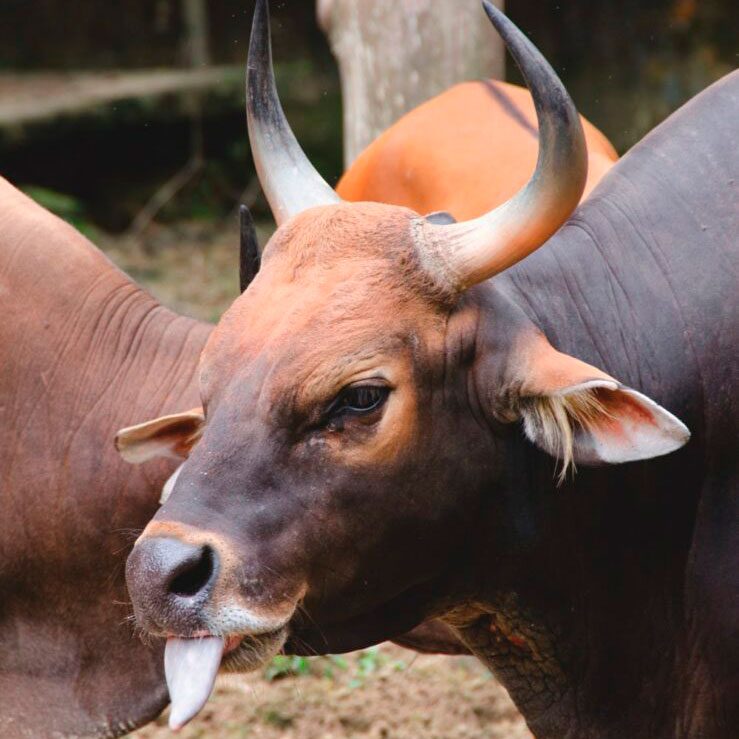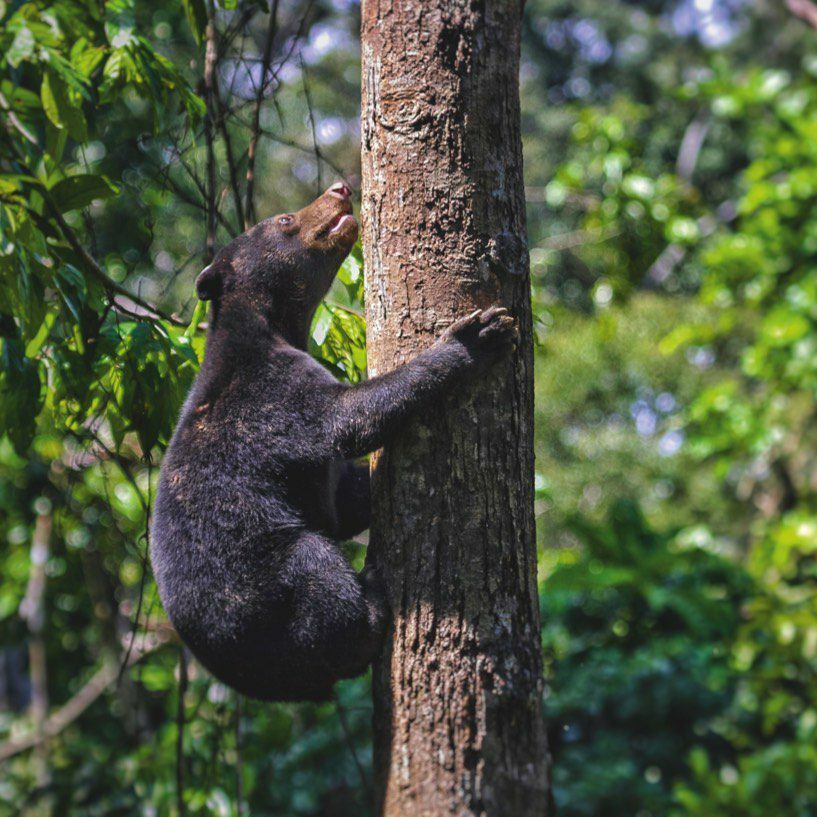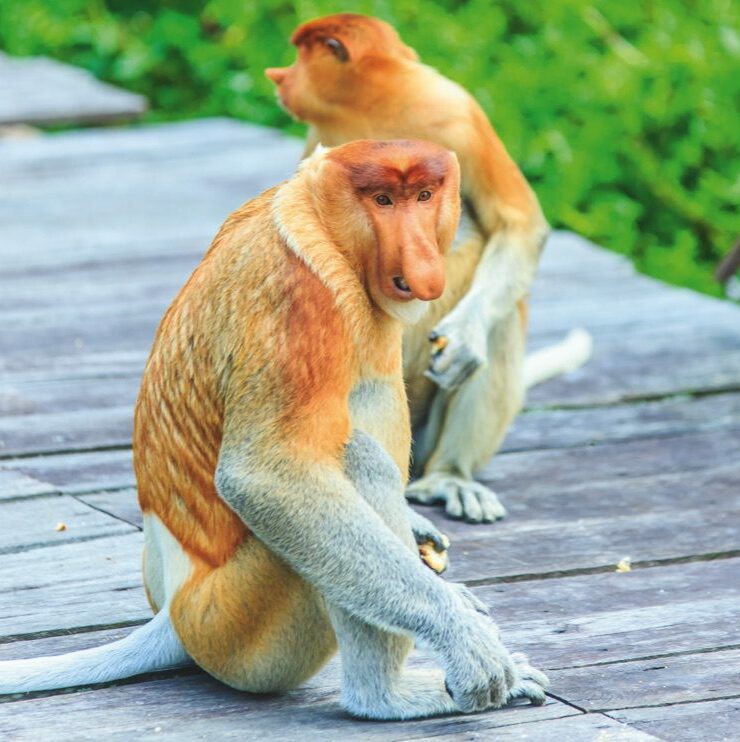Once upon a time, there was a family of orangutans on Borneo. These gentle red apes lived peacefully in the rainforest. By day they munched fruit, leaves and bark; at night they slept high in the canopy in comfortable nests woven from branches and leaves.
Then the loggers arrived and began cutting down the trees, before even bigger areas were cleared to plant oil palms.
You might imagine that what follows is a horror story. After all, the Bornean orangutan is critically endangered, its numbers plummeting by nearly two-thirds from an estimated 288,500 in 1973 to just 104,700 today. Only 11,000 wild individuals are believed to survive in Sabah, Borneo’s northernmost Malaysian state.
A major factor in their decline has been widespread destruction of this great ape’s habitat: between 2002 and 2020, Sabah lost 339,000 hectares of primary rainforest – around 10% of the total – to logging, fires and unsustainable clearance for oil palm plantations.

© AARON GEKOSKI / WWF-US
But in the ongoing tale of our orangutan family, the next chapter is still being written. And, thanks to your support, we’re hopeful the story for these magnificent primates, along with the island’s other wildlife and its people, will be more like the fairy tale this article first appeared to promise.
Malaysia is one of the few ‘megadiverse’ countries, home to huge numbers of plants and animals, particularly species found nowhere else. And Sabah is a jewel in that biodiversity crown, epitomised in its rainforest – one of the world’s oldest, dating back 130 million years – harbouring such rare and wonderful creatures as elephants, tarsiers, pangolins, hornbills, gibbons, sun bears, clouded leopards and, of course, orangutans. But that’s far from all.
“Forests still cover more than 50% of Sabah, but our rich biodiversity encompasses marine as well as terrestrial habitats,” explains Robecca Jumin, head of conservation for Sabah at WWF-Malaysia. “The state has some 300,000 hectares of mangroves, which play a critical role in regulating the world’s climate by storing significant quantities of carbon.”
Importantly, though, Sabah is also home to more than 3.8 million people, many of whom depend on these landscapes for their livelihoods. Increasingly over the past four decades, their income has derived from palm oil, which is hugely important to Sabah’s economy.
In the wild forest
It’s not just orangutans that depend on Borneo’s forests. Other species benefit from our work in Sabah

Bornean banteng
A graceful, beautiful species of wild cattle, the banteng is now endangered and largely confined to isolated forest reserves in Sabah – Tabin Wildlife Reserve is a stronghold.

Sun bear
The smallest bear species likes to climb trees in search of food – fruit, birds, termites and other insects. It’s also famously fond of honey.

Proboscis monkey
This endangered primate, endemic to Borneo and found in Sabah’s mangrove forests and riverine swamps, is known for the male’s pendulous nose, which is thought to attract females.

Sunda clouded leopard
Adorned with gorgeous ‘cloud’ markings, this vulnerable, secretive, nocturnal cat is the top predator of Borneo’s rainforest, feeding on monkeys, pigs and even small deer.

Bornean elephant
The smallest subspecies of endangered Asian elephant has a longer tail, larger ears and straighter tusks than its mainland cousin. It’s believed fewer than 1,500 wild individuals survive in Sabah.
ALL IMAGES © GETTY
Today, oil palm plantations cover more than 1.5 million hectares, or one-fifth of Sabah’s land area. In 2020, they produced 4.65 million tonnes of crude palm oil, yielding an estimated revenue of 12.5 billion Malaysian ringgits (around £2.2 billion).
Oil palm plantations have been linked with issues including deforestation and, thus, the loss of wildlife habitat and release of stored carbon. But it’s important to recognise that the crop isn’t inherently ‘bad’. Indeed, it can be highly efficient: the value of edible vegetable oil produced by a hectare planted with oil palms is five times that of the same area planted with sunflowers.
We believe that the palm oil industry can develop sustainably. So does Sabah’s government. In 2015, it declared a vision that within 10 years 100% of its palm oil output should be certified to the international standards of the Roundtable on Sustainable Palm Oil (RSPO).
Dovetailing with these aims, in 2020 we launched the Sabah Landscapes Programme. It was made possible with your support, and that of partners including Unilever and Beiersdorf (Nivea), and is based on a ‘living landscapes’ approach, working with government departments, the private sector and local communities.
Together, we identify shared sustainability goals, then put in place planning, policies and conservation measures to enable wildlife and people to thrive alongside oil palm plantations.
The idea is to foster a culture in which forests, wildlife and rivers are protected, crops are produced sustainably, and fragmented forests are restored and reconnected. In short: protect, produce, restore.
We’ve already achieved success with the ‘protect’ pillar. “Our work helped lead to the designation of Tabin Wildlife Reserve, and the Danum Valley and Maliau Basin Conservation Areas,” explains Robecca.
“Today, our teams provide technical support, with activities such as orangutan and elephant population surveys, helping steer planning, and identifying areas of high conservation value that should be protected from further development.”
Protect, produce, restore
Our living landscapes approach has three aims: protect, produce and restore. And we’re making progress with all of them…
Protecting Trusun Sugut
After decades of destructive logging, we helped push for Trusun Sugut Forest Reserve to be reclassified as a fully protected forest, safeguarding orangutans, bantengs, clouded leopards, proboscis monkeys and other incredible wildlife.
Producing palm oil sustainably
We’ve helped to set up a cooperative in Tawau to support medium-sized oil palm plantations that are becoming RSPO certified. It currently has more than 300 members, who collectively manage about 16,000 hectares.
Restoring wildlife corridors
The creation of a wildlife corridor by Sabah Softwoods in the Tawau landscape, following recommendations by WWF, has secured the passage of forest elephants through plantation areas, reducing conflict with people and cutting crop losses by around 99%.

© AARON GEKOSKI / WWF-US
Crucially, we want palm oil production to be more sustainable, measured by RSPO certification, and to allow forests and wildlife to flourish within palm oil-producing landscapes. That doesn’t just mean being better for biodiversity, though of course that’s important. It has to work for people, too.
“Certification alone will not save orangutans,” observes Robecca. “It applies only within oil palm plantations rather than across wider natural habitats.
“But it does make operations more efficient, possibly increasing production and income, without the need to expand the area planted. It also addresses issues such as environmental pollution, human rights, working conditions and soil protection,” she adds.
Supporting sustainability
Certified producers must protect areas of high conservation value or high carbon stock within their land, prevent illegal hunting, and maintain vegetation along river banks – so degraded streams must be restored to reduce pollution and erosion, and to create habitat and wildlife corridors. And certified producers are prohibited from clearing new areas of forests.
Smallholders can find it costly and difficult to improve sustainability and achieve certification, so we’re also working with the state government to help them overcome these challenges, including implementing group certification schemes.
These efforts are effective only in tandem with the protection of conservation areas and, importantly, the restoration of damaged habitats to a level in which wildlife can thrive.
Planting a new beginning
For the next five years, we’re focusing our efforts on three large-scale priority landscapes in Sabah. Together, they cover more than 100,000 sq km. Your membership is helping to fund a range of conservation interventions, including two urgent and specific pilot projects within these areas.

Lower Sugut
The lower reaches of the Sugut river basin, spanning more than 2,000 sq km in north-eastern Sabah, are dominated by protected forest reserves and large oil palm plantations. The landscape hosts Bornean orangutans, bantengs and, in mangroves and habitats close to water, proboscis monkeys. We’re working to show how land-use planning can help minimise deforestation and help inform infrastructure and agricultural developments.
Pilot project A five-year programme to restore mangroves covering some 300 hectares will secure suitable habitat for a range of wildlife, including proboscis monkeys and nurseries for fish and other aquatic life.

Tabin
This 1,200 sq km wildlife reserve is home to northern grey gibbons, sun bears and some 1,200 Bornean orangutans – the largest population in the eastern lowlands. It’s largely surrounded by oil palm plantations. We’re working with partners to halt the decline of the banteng population, and hope to create a corridor linking with Silabukan Forest Reserve to reconnect orangutan and elephant populations, and help reduce conflict between elephants and people.

Tawau
Elephants, orangutans, helmeted hornbills, clouded leopards and banteng live in Tawau Hills Park and the adjacent Ulu Kalumpang Forest Reserve, centrepieces of this landscape spanning more than 4,000 sq km. However, more than 50% is covered by oil palms. We’re working with Sabah Forestry Department and other government departments to reduce forest degradation, safeguard the habitat and improve water catchment capacity for local communities.
Pilot project With your support, we aim to restore 300 hectares of damaged and fragmented forest between Mount Wullersdorf Forest Reserve and the main Tawau Hills area initially.
One example is our pilot project at Bukit Piton Forest Reserve, a patch of the Ulu Segama-Malua landscape degraded by fires and logging. Between 2007 and 2019, we planted more than 340,000 trees over 2,200 hectares.
Some were hardy species that can cope with full sun and poor soil. They create the shade needed by others we planted, such as fruit trees that provide food for wildlife. “Orangutans are now often seen in the area, using the planted trees for food and shelter,” reports Robecca. “The presence of youngsters is a sign the habitat is improving.”
Another kind of restoration involves planting trees to create habitat corridors within plantation landscapes to connect fragmented forest patches with larger forest blocks.
For example, we’ve supported local partner Sabah Softwoods in establishing a corridor between Ulu Kalumpang Forest Reserve, Tawau Hills Park and the larger Ulu Segama Forest complex, allowing elephants access to more substantial foraging grounds.

© AARON GEKOSKI / WWF-US
This is one element of Sabah Softwoods’ strategy to avoid conflict between elephants and people. Additionally, with advice from WWF, settlements and young oil palm trees have been fenced off, while elephants are able to access parts of the plantation where any damage they might cause would be negligible, such as areas of mature trees. As a result, crop damage has been reduced by around 99%, and incidences of human-wildlife conflict have also plummeted.
As well as protecting wildlife, our Sabah Landscapes Programme also aims to enhance the livelihoods of the state’s people and increase the resilience of its ecosystems to the impacts of climate change.
“Palm oil can be an efficient crop that benefits the people of Sabah and the rest of the world,” Robecca concludes, “and it can be produced in areas that safeguard our amazing biodiversity.”
So this story might have a happy ending after all – for the orangutans, for Sabah’s people and for the other amazing wildlife that calls these precious landscapes home.
Help us protect orangutans
With your support, we can build a better future for orangutans. Adopt an orangutan today and you can help us continue our vital conservation work
More to explore

Palm oil: everything you need to know
From biscuits to bubble bath, palm oil is found in hundreds of everyday products. But why is it so popular – and so problematic? Get the facts with our guide.

